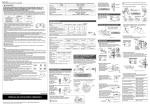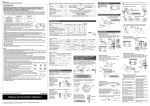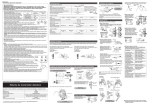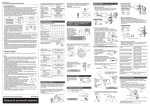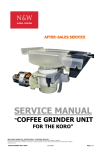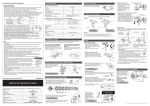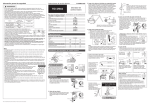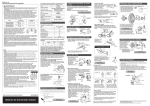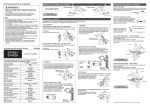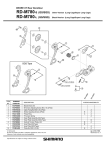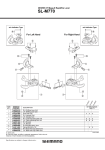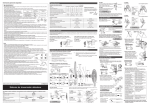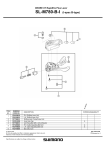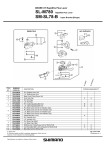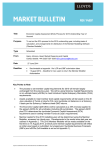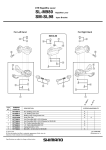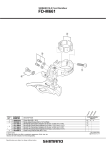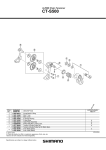Download Shimano Altus SL-M310 Front Shifter 3sp User Manual
Transcript
Rapidfire Plus Lever (2-Finger / For V-BRAKE)
ST-M310-8R2/L2 (S)
ST-M310-8R2/L2 (L)
Silver Version
Black Version
For Left Hand
For Right Hand
1
1
2
2
5
3
5
3
7
7
4
6
ITEM
NO.
1
2
3
4
5
6
7
SHIMANO
CODE NO.
Y6UH98010
Y6UJ98010
Y6UH98030
Y8UM98010
Y6PZ98070
Y6CD33000
Y6TB98060
Y6UD89000
DESCRIPTION
R.H. Indicator Unit
L.H. Indicator Unit
Reach Adjusting Screw (M4 x 14.5) & Spring
Brake Cable Adjusting Bolt & Nut
Shifting Cable Adjusting Bolt Unit
Inner Hole Cap
Main Lever Cover & Fixing Screw
Clamp Bolt (M6 x 17.5)
A: Same parts.
B: Parts are usable, but differ in materirals, appearance, finish, size, etc.
Absence of mark indicates non-interchangeability.
Specifications are subject to change without notice.
A
F5
1- 2
0- 2
36
-M
-E
ST
ST
SL
-M
31
0
A
6
4
INTERCHANGEABILITY
B
A
A
A
A
A
A
Mar.-2011-3258
© Shimano Inc. I
Rapidfire Plus Lever (4-Finger)
ST-M310-8R4/L4 (S)
ST-M310-8R4/L4 (L)
Silver Version
Black Version
For Left Hand
For Right Hand
1
1
2
2
3
6
4
3
6
4
8
8
5
7
SL
-M
31
0
ST
-M
36
0-4
A
ST
-EF
51
-4A
7
5
ITEM
NO.
1
2
3
4
5
6
7
8
SHIMANO
CODE NO.
Y6UH98010
Y6UJ98010
Y6UH98030
Y8TS98010
Y8TS98020
Y8UM98010
Y6PZ98070
Y6CD33000
Y6TB98060
Y6UD89000
DESCRIPTION
R.H. Indicator Unit
L.H. Indicator Unit
Reach Adjusting Screw (M4 x 14.5) & Spring
R.H. Adjustment Block & Fixing Screw
L.H. Adjustment Block & Fixing Screw
Brake Cable Adjusting Bolt & Nut
Shifting Cable Adjusting Bolt Unit
Inner Hole Cap
Main Lever Cover & Fixing Screw
Clamp Bolt (M6 x 17.5)
A: Same parts.
B: Parts are usable, but differ in materirals, appearance, finish, size, etc.
Absence of mark indicates non-interchangeability.
Specifications are subject to change without notice.
INTERCHANGEABILITY
B
A
A
A
A
A
A
A
A
A
A
A
Mar.-2011-3259
© Shimano Inc. I
SI-6UH0A-001-00
General Safety Information
Technical Service Instructions
WARNING
“Maintenance interval depends on the usage and riding circumstances.
Clean regularly the chain with an appropriate chaincleaner. Never use
alkali based or acid based solvents such as rust cleaners. If those
solvent be used chain might break and cause serious injury.”
• Check that the wheels are fastened securely before riding the bicycle. If the wheels are
loose in any way, they may come off the bicycle and serious injury may result.
• Use the reinforced connecting pin only for connecting the narrow type of chain.
• There are two different types of reinforced connecting pins available. Be sure to check the
table below before selecting which pin to use. If connecting pins other than reinforced
connecting pins are used, or if a reinforced connecting pin or tool which is not suitable for
the type of chain is used, sufficient connection force may not be obtained, which could
cause the chain to break or fall off.
Chain
9-speed super narrow chain
such as
CN-7701 / CN-HG93
8- / 7- / 6-speed narrow
chain such as
CN-HG50 / CN-HG40
Reinforced
connecting pin
Chain tool
SI-6UH0A-001
Rear Drive System
In order to realize the best performance, we recommend that the
following combination be used.
Rapidfire Plus
ST-M310-8R
Outer casing
SP40
RD-M310
Rear derailleur
Type
Smart Cage
Freehub
FH-RM30-8
8
Gears
Silver
TL-CN32 / TL-CN27
Black
TL-CN32 / TL-CN27
For each sprocket, the
surface that has the group
mark should face outward
and be positioned so that
the triangle (U) mark on
each sprocket and the A
part (where the groove
width is wide) of the
freewheel body are aligned.
For installation of the HG sprockets, use the
special tool (TL-LR15 / LR10) to tighten the
lock ring.
Tightening torque:
30 - 50 N·m {261 - 434 in. lbs.}
To replace the HG sprockets, use the special
tool (TL-LR15 / LR10) and TL-SR21 to remove
the lock ring.
Lock ring
U mark
A
Chain
CN-HG50 / CN-HG40
Bottom bracket guide
SM-SP18 / SM-BT18
Insert the inner cable into the outer casing from the end with the marking on it.
Apply grease from the end with the marking in order to maintain
cable operating efficiency.
Marking
Cutting the outer casing
When cutting the outer casing, cut the opposite end to
the end with the marking. After cutting the outer casing,
make the end round so that the inside of the hole has a
uniform diameter.
Attach the same outer end cap to the
cut end of the outer casing.
The groove is
wide at one
place only.
Tool
(TL-SR21)
TL-LR15/LR10
Disassembly
3. Low adjustment
Largest sprocket
Turn the low adjustment screw so
that the guide pulley moves to a
position directly in line with the
largest sprocket.
1
Note
• If gear shifting operations do not feel smooth, wash the derailleur and lubricate all moving
parts.
• If the amount of looseness in the links is so great that adjustment is not possible, you should
replace the derailleur.
• You should periodically clean the derailleur and lubricate all moving parts (mechanism and
pulleys).
• If gear shifting adjustment cannot be carried out, check the degree of parallelism at the rear
end of the bicycle. Also check if the cable is lubricated and if the outer casing is too long or
too short.
• If you hear abnormal noise as a result of looseness in a pulley, you should replace the
pulley.
• If the wheel becomes stiff and difficult to turn, you should lubricate it with grease.
• Do not apply any oil to the inside of the hub, otherwise the grease will come out.
• You should periodically wash the sprockets in a neutral detergent and then lubricate them
again. In addition, cleaning the chain with neutral detergent and lubricating it can be a
effective way of extending the useful life of the sprockets and the chain.
• If the chain keeps coming off the sprockets during use, replace the sprockets and the chain.
• Always be sure to use the sprocket set bearing the same group marks. Never use in
combination with a sprocket bearing a different group mark.
• Use a frame with internal cable routing is strongly discouraged as it
Group marks
has tendencies to impair the SIS shifting function due to its high cable
resistance.
• Use an outer casing which still has some length to spare even when
the handlebars are turned all the way to both sides. Furthermore,
check that the shifting lever does not touch the bicycle frame when the
handlebars are turned all the way.
• Grease the inner cable and the inside of the outer casing before use
to ensure that they slide properly.
• Operation of the levers related to gear shifting should be made only
when the front chainwheel is turning.
• Parts are not guaranteed against natural wear or deterioration resulting from normal use.
• For maximum performance we highly recommend Shimano lubricants and maintenance
products.
• For any questions regarding methods of installation, adjustment, maintenance or operation,
please contact a professional bicycle dealer.
ag - 18T
ag -15
T
Specifications
RD-M310
Type
Smart Cage
Total capacity
43T
Largest sprocket
34T
Smallest sprocket
11T
Front chainwheel tooth difference
Add 2 links (with the chain on both the largest
sprocket and the largest chainring)
Sprockets
Group name
Tooth combination
8
an
11, 13, 15, 17, 20, 23, 26, 30T
8
aw
11, 13, 15, 18, 21, 24, 28, 32T
8
ao
11, 13, 15, 17, 20, 23, 26, 34T
Gear shifting operation
To shift from a small sprocket to a
larger sprocket (Lever A)
To shift from a large sprocket to a
smaller sprocket (Lever B)
To shift one step only, press lever (A) to
the (1) position. To shift two steps at
one time, press to the (2) position.
Press lever (B) once to shift one step
from a larger to a smaller sprocket.
Lever (A) initial position
Use a handlebar grip with a maximum
outer diameter of 36 mm.
SIS Adjustment
1. Top adjustment
Lever (B)
Turn the top adjustment screw to adjust
so that the guide pulley is in line with the
outer line of the smallest sprocket when
looking from the rear.
SH
IM
Adjusting the grip width
2
2
Top adjustment
screw
2. Connecting and securing the inner cable
Lever (B)
It is recommended that you adjust the grip
widths of the levers to the most comfortable
widths for gear shifting and braking.
Inner cable
Inner hole cover
A : Becomes narrower
B : Becomes wider
Bracket spindle tightening torque:
8 - 10 N·m {70 - 86 in. lbs.}
2
B-tension
adjustment screw
Operate the shifting lever several times to move the chain to the 2nd sprocket.
Then, while pressing the lever just enough to take up the play in the lever, turn
the crank arm.
When shifting to
3rd
When no sound at
all is heard
Outer casing
adjustment
barrel
Outer casing
adjustment
barrel
Tighten the outer cable adjusting
barrel until the chain returns to
the 2nd sprocket. (clockwise)
Loosen the outer casing
adjustment barrel until the chain
touches the 3rd sprocket and
makes noise. (counter clockwise)
Connect the cable to the
rear derailleur and, after
taking up the initial slack in
the cable, re-secure to the
rear derailleur as shown in
the illustration.
Note: Be sure that the cable is
securely in the groove.
The best setting is when the shifting lever is operated just
enough to take up the play and the chain touches the 3rd
sprocket and makes noise.
* Return the lever to its original position (the position where
the lever is at the 2nd sprocket setting and it has been
released) and then turn the crank arm clockwise. If the chain
is touching the 3rd sprocket and making noise, turn the outer casing
adjustment barrel clockwise slightly to tighten it until the noise stops and
the chain runs smoothly.
Operate lever to change gears, and check that no noise occurs in any of
the gear positions.
After removing the hub axle,
remove the freewheel body fixing
bolt (inside the freewheel body),
and then replace the freewheel
body.
Note:
Do not attempt to disassemble
the freewheel body, because it
may result in a malfunction.
Pull
Tightening torque :
5 - 7 N·m {44 - 60 in. lbs.}
Best setting
Replacement of the freewheel body
Inner hole cover
O
AN
HYPERGL I DE - C
3-77 Oimatsu-cho, Sakai-ku, Sakai-shi, Osaka 590-8577, Japan
Dropout tab
1
1
For the best SIS performance, periodically lubricate all power-transmission
parts.
Install the inner hole cover by turning it as shown in
the illustration until it stops.
Do not turn it any further than this, otherwise it may
damage the screw thread.
When installing, be careful that deformation is not caused by the B-tension
adjustment screw coming into contact with the dropout tab.
B-tension adjustment screw
Please note: specifications are subject to change for improvement without notice. (English)
© Nov. 2010 by Shimano Inc. XBC IZM Printed in Singapore.
1
Operate lever (B) 7 times or more, and check on
the indicator that the lever is at the highest
position. Then remove the inner hole cover and
connect the inner cable.
Installation of the rear derailleur
* Service Instructions in further languages are available at : http://techdocs.shimano.com
Outer line of
smallest sprocket
1
3T
Industrieweg 24, 8071 CT Nunspeet, The Netherlands Phone: +31-341-272222
Smallest sprocket
5. SIS Adjustment
Mounting the shifting lever
Guide pulley
One Holland, Irvine, California 92618, U.S.A. Phone: +1-949-951-5003
2
5 mm Allen key
Both lever (A) and lever (B) always return to the initial position when they are
released after shifting. When operating one of the levers, always be sure to turn
the crank arm at the same time.
5 mm Allen key
Largest sprocket
Chain
Allen key tightening torque:
6 - 8 N·m {53 - 69 in. lbs.}
ag
-1
This service instruction explains how to use and maintain the Shimano bicycle parts which have
been used on your new bicycle. For any questions regarding your bicycle or other matters which
are not related to Shimano parts, please contact the place of purchase or the bicycle manufacturer.
Largest chainring
20T
Cassette sprocket tooth combination
CS-HG31-8
Largest chainring
FC-M361 / M311 (48-38-28T / 42-32-22T)
FC-M361-8 / M311-8 (42-32-22T)
Applicable front chainwheel
(chainring tooth configuration)
Model number
Chain length
Mount the chain on the smallest chainring
and the largest sprocket, and turn the
2
crank arm backward. Then turn the Btension adjustment screw to adjust the
guide pulley as close to the sprocket as
possible but not so close that it touches.
Next, set the chain to the smallest
sprocket and repeat the above to make
sure that the pulley does not touch the
1
sprocket.
2
Low adjustment
screw
1
4. How to use the B-tension adjustment screw
Lock ring
Rear Derailleur
Model number
Guide pulley
2
7.1mm
Reinforced Connecting Pin
• If it is necessary to adjust the length of the chain due to a
change in the number of sprocket teeth, make the cut at
some other place than the place where the chain has been
joined using a reinforced connecting pin or an end pin. The
chain will be damaged if it is cut at a place where it has
End Pin
Link Pin
been joined with a reinforced connecting pin or an end pin.
• Check that the tension of the chain is correct and that the chain is not damaged. If the
tension is too weak or the chain is damaged, the chain should be replaced. If this is not
done, the chain may break and cause serious injury.
• Obtain and read the service instructions carefully prior to installing the parts. Loose,
worn or damaged parts may cause the bicycle to fall over and serious injury may occur as a
result. We strongly recommend only using genuine Shimano replacement parts.
• Obtain and read the service instructions carefully prior to installing the parts. If
adjustments are not carried out correctly, the chain may come off and this may cause you to
fall off the bicycle which could result in serious injury.
• Read these Technical Service Instructions carefully, and keep them in a safe place for later
reference.
Outer end cap
ac -14T
CS-HG31-8
Cassette sprocket
6.5mm
Inserting the inner cable
Installation of the sprockets
Groove
Tightening torque:
35 - 50 N·m {305 - 434 in. lbs.}
Freewheel body
Freewheel body fixing bolt
Disassembly
Assembly
Freewheel body washer
10 mm Allen key
(TL-WR37)
SI-6UJ0A-002-00
General Safety Information
Gears
WARNING
“Maintenance interval depends on the usage and riding circumstances. Clean regularly the
chain with an appropriate chaincleaner. Never use alkali based or acid based solvents such
as rust cleaners. If those solvent be used chain might break and cause serious injury.”
• Use the reinforced connecting pin only for connecting the narrow type of chain.
• There are two different types of reinforced connecting pins available. Be sure to check the table below before selecting
which pin to use. If connecting pins other than reinforced connecting pins are used, or if a reinforced connecting pin or
tool which is not suitable for the type of chain is used, sufficient connection force may not be obtained, which could
cause the chain to break or fall off.
Chain
9-speed super narrow chain
such as
CN-7701 / CN-HG93
8- / 7- / 6-speed narrow chain
such as
CN-HG50 / CN-HG40
The level section of the chain
guide outer plate should be
directly above and parallel to the
largest chainring. Secure using a
5 mm Allen key.
In order to realize the best performance, we recommend that the following combination be used.
Reinforced
connecting pin
TL-CN32 / TL-CN27
Black
TL-CN32 / TL-CN27
SIS 8-gears
Left
SIS 3-gears
ST-M310-L
Rapidfire Plus
FD-M311 / FD-M310 / FD-M190-3 / FD-M190A / FD-M191
Front derailleur
Tightening torque :
5 - 7 N·m {44 - 60 in. lbs.}
CN-HG50 / CN-HG40
Chain
Chain length
SM-SP17 / SM-BT17 / SM-SP18 / SM-BT18
Model number
FD-M311 / FD-M310
FD-M191
FD-M190-3
FD-M190A
X
X
X
X
Normal type
X
X
X
X
Front chainwheel tooth difference
20T
20T
18T
18T
Min. difference between top and intermediate
10T
10T
8T
8T
S, M, L
S, M, L
Top route type
Front derailleur installation band diameter
Applicable chain line
47.5 / 50 mm
47.5 / 50 mm
3-77 Oimatsu-cho, Sakai-ku, Sakai-shi, Osaka 590-8577, Japan
* Service Instructions in further languages are available at : http://techdocs.shimano.com
Please note: specifications are subject to change for improvement without notice. (English) © Feb. 2011 by Shimano Inc. XBC IZM Printed in Singapore.
M311
Top route type
Pull
Pull
S, M, L
S, M, L
66°- 69°
47.5 / 50 mm
47.5 / 50 mm
Chainstay angle
Tightening torque:
6 - 8 N·m {53 - 69 in. lbs.}
3. Top adjustment
FC-M361 / FC-M311 FC-M361-8 / FC-M311-8
Model number
42T-32T-22T
48T-38T-28T
42T-32T-22T
FC-M171 / FC-M131
FC-M171 / FC-M131
48T-38T-28T
42T-34T-24T
—
—
—
—
170 mm, 175 mm
170 mm, 175 mm
170 mm
170 mm
BC 9/16" X 20 T.P.I. (English thread)
Pedal thread dimensions
FD-M311 / FD-M310
Applicable chain line
FD-M191
50 mm
BB-UN26 (-K)
Applicable bottom bracket
Set so that the clearance between the chain guide outer plate and
the chain is 0-0.5 mm.
FD-M190-3 / FD-M190A
47.5 mm / 47.5 mm + t *
BB-ES25 (-K)
BB-UN26 (-K)
FD-M311
SIS adjustment
Chain position
Be sure to follow the sequence described below.
Smallest sprocket
1. Low adjustment
Largest chainring
First remove the Pro-Set alignment block.
Next, set so that the clearance between the chain guide
inner plate and the chain is 0-0.5 mm.
BB-UN26 (-K)
Model number
FD-M311
BB-UN26 (-K) BB-UN26 (-K) BB-ES25 (-K)
Spindle length
123 mm
Chain line 47.5 mm
Chain line 50 mm
122.5 mm
—
D-NL
—
—
126 (K)
Chain line
47.5 mm + t *
—
Thread dimensions
BC 1.37" X 24 T.P.I. (68, 73 mm)
D-NL K
—
* t = Chain case thickness (1.5 -- 2.1 mm)
Chain guide outer
plate
Chain
Low adjustment
screw
126 mm
LL123 (K)
Top adjustment
screw
FD-M310
FD-M191
FD-M190-3
FD-M190A
Bottom Bracket
Installation of the Front Derailleur,
Bottom Bracket and Front Chainwheel
Use the special tools (TL-UN65 and TL-UN74-S) to install the
bottom bracket 1 and the front derailleur so that they face as
shown in the illustration. Install the adapter 2, and then use
the cotterless crank extractor (TL-FC10) to install the front
chainwheel.
Pro-Set alignment block
Chain position
Largest sprocket
Smallest
chainring
FD-M310
FD-M191
FD-M190-3
FD-M190A
Chain guide
inner plate
4. Adjustment of the intermediate chainring
When carrying out adjustment, set the chain to the largest sprocket,
and at the front, set the chain to the intermediate chainring. Adjust
using the outer casing adjustment barrel so that the clearance
between the chain guide inner plate and the chain is 0-0.5 mm.
Chain
Chain position
Largest
sprocket
Intermediate
chainring
Front Derailleur
3 Front Chainwheel
Both lever (A) and lever (B) always return to the initial position
when they are released after shifting.
When operating one of the levers, always be sure to turn the
crank arm at the same time.
To shift from a small chainring to a larger chainring
(Lever A)
When lever (A) is
pressed once, there is a
shift of one step from a
small chainring to a
larger chainring.
Lever (A) initial position
1 Bottom Bracket
Pro-Set alignment block
Lever (B)
B
Chain
When lever (B) is
pressed once, there is a
shift of one step from a
large chainring to a
smaller chainring.
Pro-Set gauge
1 mm
3 mm
Outer casing adjustment barrel
Inner cable
5. Troubleshooting chart
Install the inner hole cover by turning
it as shown in the illustration until it
stops.
Do not turn it any further than this,
otherwise it may damage the screw
thread.
Gear teeth
should come
within this range
To shift from a large chainring to a smaller chainring
(Lever B)
After completion of steps 1 - 4, move the shifting lever to check the
shifting. (This also applies if shifting becomes difficult during use.)
If the chain falls to the crank side.
Inner hole cover
Inserting the inner cable
Insert the inner cable into the outer casing from the end with
the marking on it. Apply grease from the end with the
marking in order to
maintain cable operating
efficiency.
Marking
Example:
Cutting the outer casing
Adjusting the grip width
When cutting the outer casing, cut the opposite end to the
end with the marking. After cutting the
outer casing, make the end round so
that the inside of the hole has a
uniform diameter.
It is recommended that you adjust the grip widths of the levers
to the most comfortable widths for gear shifting and braking.
Attach the same outer end cap to the cut end of the outer
casing.
A : Becomes narrower
B : Becomes wider
Lever (B)
A
Chain guide
inner plate
Inner hole cover
Adapter / bottom bracket tightening torque:
50 - 70 N·m {435 - 608 in. lbs.}
Front chainwheel tightening torque:
35 - 50 N·m {305 - 435 in. lbs.}
Adjust and then install the front derailleur as shown in the
illustration. Do not remove the Pro-Set alignment block at this
time.
from intermediate
chainring to largest
chainring.
from largest chainring to
intermediate chainring.
2 Adapter
2. Connecting and securing the inner cable
Operate lever (B) two
times or more, and check
on the indicator that the
lever is at the lowest
position. Then remove the
inner hole cover and
connect the inner cable.
Gear shifting operation
Example:
Industrieweg 24, 8071 CT Nunspeet, The Netherlands Phone: +31-341-272222
Normal type
5 mm Allen key
Applicable front derailleur
One Holland, Irvine, California 92618, U.S.A. Phone: +1-949-951-5003
M190-3/M190A
After taking up the initial slack in the cable, re-secure to the front
derailleur as shown in the illustration.
Mounting the shifting lever
Chainwheel
Note
This service instruction explains how to use and maintain the Shimano bicycle parts which have been used on your new
bicycle. For any questions regarding your bicycle or other matters which are not related to Shimano parts, please contact
the place of purchase or the bicycle manufacturer.
M191
Installation band diameters: S [28.6 mm], M [31.8 mm], L [34.9 mm] (Use the adapter for S and M sizes.)
Crank arm length
Front Drive System
M310
Use a handlebar grip with a maximum
outer diameter of 36 mm.
63°- 66°
63°- 66° / 66°- 69°
Chainstay angle (a)
Bolt circle diameter
SI-6UJ0A-002
Largest chainring
X = Available
• If the chain is on the smallest or intermediate chainring, there is the danger of injury from the tips of the teeth on the
largest chainring.
Technical Service Instructions
Largest sprocket
Chain
Front Derailleur
Chainwheel tooth combination
• In addition, if pedaling performance does not feel normal, check this once more.
• Before riding the bicycle, check that there is no play or looseness in the connection. Also, be sure to retighten the crank
arms and pedals at periodic intervals.
• When installing the pedals, apply a small amount of grease to the threads to prevent the pedals from sticking. Use a
torque wrench to securely tighten the pedals. Tightening torque: 35 - 55 N·m {305 - 479 in. lbs.}. The right-hand crank
arm has a right-hand thread, and the left-hand crank arm has a left-hand thread.
• Do not wash the bottom bracket with high-pressure jets of water.
• If you feel any looseness in the bottom bracket axle, the bottom bracket should be replaced.
• If gear shifting operations do not feel smooth, wash the derailleur and lubricate all moving parts.
• If the amount of looseness in the links is so great that adjustment is not possible, you should replace the derailleur.
• You should periodically wash the chainrings in a neutral detergent and then lubricate them again. In addition, cleaning
the chain with neutral detergent and lubricating it can be a effective way of extending the useful life of the chainrings and
the chain.
• The cuffs of your clothing may get dirty from the chain while riding.
• If the chain keeps coming off the chainrings during use, replace the chainrings and the chain.
• When the chain is in the position shown in the illustration, the chain may contact
the front chainrings or front derailleur and generate noise. If the noise is a
Front
problem, shift the chain onto the next-larger rear sprocket or the one after.
chainrings
• Apply grease to the bottom bracket before installing it.
• For smooth operation, use the specified outer casing and the bottom bracket
cable guide.
Rear
• This front derailleur is for triple front chainwheel use only. It cannot be used with
sprockets
the double front chainwheel, as the shifting points do not match.
• When installing the top route type, choose a frame that has three outer casing
Outer casing holders
holders as shown in the illustration at right.
• Use an outer casing which still has some length to spare even when the handlebars are turned all
the way to both sides. Furthermore, check that the shifting lever does not touch the bicycle frame
when the handlebars are turned all the way.
• Grease the inner cable and the inside of the outer casing before use to ensure that they slide
properly.
• Operation of the levers related to gear shifting should be made only when the front chainwheel is
turning.
• Parts are not guaranteed against natural wear or deterioration resulting from normal use.
• For maximum performance we highly recommend Shimano lubricants and maintenance products
• For any questions regarding methods of installation, adjustment, maintenance or operation, please contact a
professional bicycle dealer.
< FD-M311 >
Note:
Pass the cable through as
shown in the illustration.
BB-UN26 (-K) / BB-ES25 (-K)
Bottom bracket
Specifications
CAUTION
< FD-M310 / M191 / M190-3 / M190A >
FC-M361 / FC-M361-8 / FC-M311 / FC-M311-8 / FC-M171 / FC-M131
Front chainwheel
6.5mm
Reinforced Connecting Pin
• If it is necessary to adjust the length of the chain due to a change in the number of
sprocket teeth, make the cut at some other place than the place where the chain has
been joined using a reinforced connecting pin or an end pin. The chain will be
damaged if it is cut at a place where it has been joined with a reinforced connecting
pin or an end pin.
End Pin
Link Pin
• Be careful not to let the cuffs of your clothes get caught in the chain while riding,
otherwise you may fall off the bicycle.
• Check that the tension of the chain is correct and that the chain is not damaged. If the tension is too weak or the chain is
damaged, the chain should be replaced. If this is not done, the chain may break and cause serious injury.
• It is important to periodically check the tightening torques for the crank arms and pedals. After riding approximately 100
km (60 miles), re-check the tightening torques. If the tightening torques are too weak, the crank arms or pedals may
come off and the bicycle may fall over, and serious injury may occur as a result.
• Check that there are no cracks in the crank arms before riding the bicycle. If there are any cracks, the crank arm may
break and you may fall off the bicycle.
• Obtain and read the service instructions carefully prior to installing the parts. Loose, worn or damaged parts may
cause the bicycle to fall over and serious injury may occur as a result. We strongly recommend only using genuine
Shimano replacement parts.
• Obtain and read the service instructions carefully prior to installing the parts. If adjustments are not carried out
correctly, the chain may come off and this may cause you to fall off the bicycle which could result in serious injury.
• Read these Technical Service Instructions carefully, and keep them in a safe place for later reference.
Use a 5 mm Allen key to tighten the wire fixing bolt.
Cut off the excess length of inner cable and then install the inner end
cap.
Tightening torque :
5 - 7 N·m {44 - 60 in. lbs.}
Add 2 links (with the chain on
both the largest sprocket and
the largest chainring)
7.1mm
Chainwheel
(largest chainring)
Chain guide
OT-SP40
Outer casing
Bottom bracket cable guide
Chain tool
Silver
Right
Outer end cap
Tighten the top adjustment screw
clockwise (about 1/4 turn).
If shifting is difficult from the
Loosen the top adjustment screw
intermediate chainring to the largest counterclockwise (about 1/8 turn).
chainring.
If shifting is difficult from the
intermediate chainring to the
smallest chainring.
Loosen the low adjustment screw
counterclockwise (about 1/4 turn).
If there is interference between the
chain and the front derailleur inner
plate at the largest chainring.
Tighten the top adjustment screw
clockwise (about 1/8 turn).
If there is interference between the
chain and the front derailleur outer
plate at the largest chainring.
Loosen the top adjustment screw
counterclockwise (about 1/8 turn).
If the intermediate chainring is
skipped when shifting from the
largest chainring.
Loosen the outer casing adjustment
barrel counterclockwise
(1 or 2 turns).
If there is interference between the Tighten the outer casing adjustment
chain and front derailleur inner plate barrel clockwise (1 or 2 turns).
when the rear sprocket is shifted to
the largest sprocket when the
chainwheel is at the intermediate
chainring position.
If the chain falls to the bottom
bracket side.
Tighten the low adjustment screw
clockwise (about 1/2 turn).




